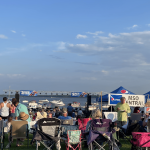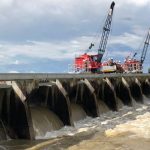Based on the reduced flows in the Mississippi River at Red River Landing, the U.S. Army Corps of Engineers, New Orleans District will begin closing bays at the Bonnet Carré Spillway this morning.
Initially, the Corps will close 10 of the 168 bays currently open. Operations were expected to begin at 9 a.m. The Corps will continue to assess conditions of the Mississippi River and perform closure operations based upon these conditions.

The Bonnet Carré Spillway is designed to ensure that a maximum river flow of 1.25 million cubic feet per second (cfs) is passed through Mississippi River and Tributaries system at New Orleans. Because the river has receded below the maximum flow at Red River Landing, the diversion of water into Lake Pontchartrain is no longer needed to safely pass the river flow through the New Orleans area.
Today marks the 74 day the structure has been opened during this operation and during the peak 161,000 cfs was being diverted through the flood control structure. This operation marks the first time the structure has been operated twice in one year and the first time it has been operated in back-to-back years.
Although water levels are receding, allowing the structure’s closure, the Mississippi River in the New Orleans District’s area of responsibility remains elevated. In the interest of public safety, the Corps will continue its flood fight operations, environmental monitoring and all subsurface construction restrictions remain in effect.
*****
Bonnet Carré Spillway, located 28 miles above New Orleans, is a vital element of the multi-state Mississippi River and Tributaries (MR&T) system, which uses a variety of features to provide flood risk reduction to the alluvial Mississippi Valley from Cape Girardeau, MO to Head of Passes, LA. Located on the east bank in St. Charles Parish, it can divert a portion of the river’s floodwaters via Lake Pontchartrain into the Gulf of Mexico, thus allowing high water to bypass New Orleans and other nearby river communities. The structure has a design capacity of 250,000 cfs, the equivalent of roughly 1,870,000 gallons per second.
The Bonnet Carré structure consists of a control structure and a floodway. The control structure is a concrete weir that parallels the river for a mile and a half. It consists of 350 gated bays, each holding 20 timber “needles,” for a total of 7,000 needles. When needles are removed, river water flows into the floodway and is conveyed nearly six miles between guide levees to the lake. Operation of the structure is relatively simple. Two cranes, moving on tracks atop the structure, lift timbers from their vertical position in the weir and set them horizontally across the top of the structure to allow river water into the spillway.







